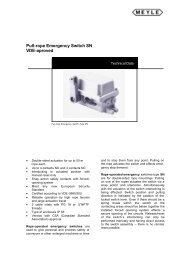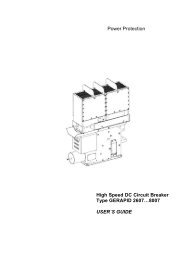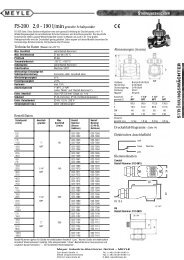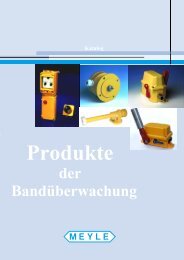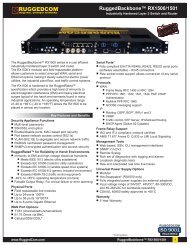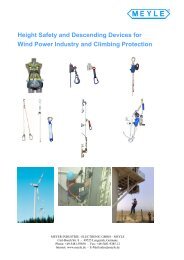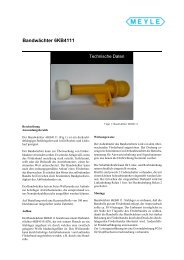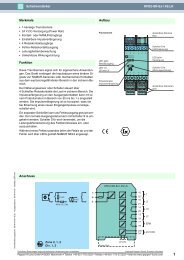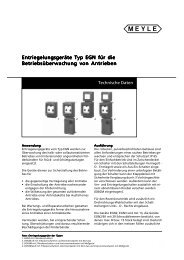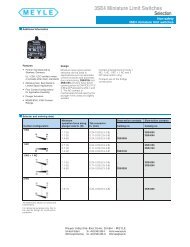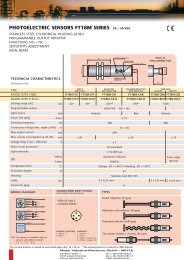INCREMENTAL ENCODER MyInc - MEYER Industrie-Electronic ...
INCREMENTAL ENCODER MyInc - MEYER Industrie-Electronic ...
INCREMENTAL ENCODER MyInc - MEYER Industrie-Electronic ...
You also want an ePaper? Increase the reach of your titles
YUMPU automatically turns print PDFs into web optimized ePapers that Google loves.
20<br />
GENERAL/OVERVIEW<br />
General<br />
Profibus: General Information The basic functions of the PROFIBUS DP<br />
are only described in extracts in here.<br />
®<br />
For additional information, please refer to<br />
Introduction The Meyle Profibus encoders are absolute<br />
encoders. The version described sends its<br />
current position to another station via the<br />
transmission medium "PROFIBUS DP"<br />
(physically: screened and twisted pair line).<br />
The Profibus encoder supports all class 1<br />
and 2 functions listed in the encoder profile.<br />
PROFIBUS-DP is standardised and binding,<br />
but manufacturer-independent definition for<br />
a variety of applications in the field of production,<br />
process and automation. The<br />
requirements of openness and independence<br />
from the manufacturer are stipulated in<br />
the European standard EN 50 170.<br />
Field of application In systems, where the position of a drive or<br />
of any other part of a machine has to be<br />
recorded and transmitted to the control<br />
system, the encoder is doing this function.<br />
The encoder can resolve, for instance,<br />
Basic function of the Profibus DP The central control system (master) cyclically<br />
reads out the input information from the<br />
slaves and transmits the output information<br />
to the slaves. For this purpose, the bus cycle<br />
time has to be shorter than the program<br />
cycle time of the central control system<br />
(e.g. SPC, or IPC), which amounts to approx.<br />
10 ms for several applications. Beside the<br />
PROFIBUS DP Basic Functions<br />
Transmission technology:<br />
RS-485 twisted pair line<br />
Baud rates ranging from 9.6 kbit/s up<br />
to 12 Mbit/s<br />
Bus access:<br />
Monomaster or multimaster systems<br />
possible<br />
Token passing procedure between the<br />
masters and master-slave procedures<br />
for slaves<br />
Master and slave devices, max. of<br />
126 stations at a single bus<br />
Communication:<br />
Point-to-point (user data communication)<br />
or multicas (control commands)<br />
Cyclical master-slave user data communication<br />
and acyclical master-master<br />
data transfer<br />
Operating state:<br />
Operate: cyclical transfer of input and<br />
output data<br />
Stop: only master-master data transfer is<br />
possible<br />
Clear: The input data are read, the output<br />
data remain in the safe status<br />
Synchronisation: Control commands<br />
enable a synchronisation of the input<br />
and output data<br />
Sync mode: Output data are being synchronised<br />
Functionality:<br />
Address assignment for the DP slaves via<br />
the bus<br />
Cyclical user data transfer between DP<br />
master and DP slave(s)<br />
Configuration of the DP master (DPM1)<br />
via the bus<br />
Single DP slaves are dynamically<br />
activated or deactivated<br />
Control of the DP slave's configuration.<br />
Powerful diagnostic functions, 3 stepped<br />
diagnostic message levels.<br />
Meyer <strong>Industrie</strong>-<strong>Electronic</strong> GmbH – MEYLE<br />
Carl-Bosch-Straße 8<br />
49525 Lengerich/Germany<br />
Tel.: +49 54 81-93 85-0<br />
Fax: +49 54 81-93 85-12<br />
the standards on PROFIBUS DP, i.e.<br />
DIN 19245-3 and EN 50170 respectively.<br />
PROFIBUS-DP permits the communication<br />
of devices produced by different manufacturers<br />
without any particular adaptations of<br />
the interfaces. PROFIBUS DP is a special<br />
standard version for a quick data exchange<br />
within the field level which has been optimised<br />
in terms of speed and low connection<br />
costs. Central with local field devices like<br />
drives, valves, or encoders. The data<br />
exchange between these devices is pre -<br />
dominantly cyclical. The communication<br />
functions required for this exchange are<br />
determined by the functions of the<br />
PROFIBUS DP according to the EN 50 170<br />
European standard.<br />
positioning tasks by sending the feedback<br />
signal concerning the present drive position<br />
via the PROFIBUS DP to the positioning unit.<br />
cyclical user data transfer, the PROFIBUS<br />
DP version also disposes of powerful<br />
functions for diagnosis and initial operation<br />
procedures. The data traffic is controlled by<br />
watchdog functions on both the slave and<br />
the master side. In the following the basic<br />
functions of the PROFIBUS DP are<br />
summarised in short.<br />
Maximum of 246 byte input and output<br />
data per DP slave possible<br />
Synchronisation of in- and/ or output<br />
Protection functions:<br />
Access protection of the DP slaves' input/<br />
output<br />
All messages are transferred with a hamming<br />
distance of HD=4<br />
Response control at the DP slaves<br />
Monitoring of the user data communication<br />
with adjustable control timer at the master<br />
Device types:<br />
DP master class 2 (DPM2), e.g. programming/<br />
project planning devices<br />
DP master class 1 (DPM1), e.g. central<br />
automation devices like SPC, PC<br />
DP slave e. g. devices with binary or analogue<br />
input/output, drives, valves<br />
Internet: www.meyle.de<br />
E-Mail: sales@meyle.de




